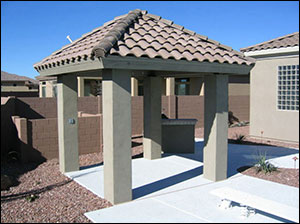It’s all about SHADE!
Let’s just hope we don’t have too many 110 degree plus days this summer…ugh!!! If you are an outdoor enthusiast and love spending time by the pool no matter what the temperature, having relief near by is always welcome. Over the years, I have built dozens of shade structures using a variety of different materials. Before we go into the numerous options, let’s talk about the many names we use to describe them and their associated meanings. Gazebos, Arbors, Ramada’s, Pergolas are the most common names, but what are the differences?
Gazebos offer protection from both the sun and rain because they have a solid tiled roof that matches the home. These are free standing structures that usually are not attached to the house. The interior finished ceiling is either exposed framework, or the framework is covered using a tongue & groove high grade plywood. Most people install a light & ceiling fan with a switch on one of the support posts, and others go as far as installing a misting system on the perimeter for additional comfort. The support posts are built with masonry block (CMU), require a solid footing, and can be finished off with stucco & paint, or maybe a stone veneer. A good Gazebo starts at about $10,000 for a 10×10 or 12×12, but I have built others that cost $15,000 to $20,000. It all depends on how you accessorize and the materials you choose. Because Gazebo’s usually finish off at a height of 10 to 12 feet above ground level, just about all require HOA approval and a building permit. They are not hard to get, but that is the correct way to go about it. Gazebos are one of the more expensive shade options, but are extremely functional and decorative.
 Another shade option is the ramada, which sometimes is called an arbor or pergola. In Arizona these words seem interchangeable, but they really all mean the same thing. A ramada or arbor offers no protection from the rain, but does offer “filtered” sunlight, as well as a very attractive decorative element. These can either be free standing structures or attached to the house. The support posts can be wood or masonry, and the top can have anywhere between one and three layers depending on how much shade you require. Two and three layered arbors are usually the norm. I recommend three especially if you are using wood, because the cross member building approach helps to keep the wood from twisting. I like using a “rough sawn” fir because it holds up well to Arizona weather and stains or paints beautifully. The three layered arbor top starts with a first course of main beams with dimensions of 6” x 12”. I like a “beefy” looking structure. I corbel the ends for decoration and the corners are cross woven into one another. The second course is a 3” x 6” member laid perpendicular to the first, and also has corbeled ends. The final layer is 3’ x 3” and is laid perpendicular to the course below. Ends are usually too small to corbel, so I’ll straight cut them or slightly round over the ends. It’s also best that you stain or paint the wood on the ground so you can cover every inch of wood before it is assembled. It also makes staining or painting much easier when you can place them on a saw horse as opposed to working overhead. Wood still has a tendency to twist, so make sure the wood is as dry as it can be from the lumber yard. Cracking in some of these beams is expected and is commonly called “checking”. Unless severe… checking usually doesn’t effect the strength integrity of the wood.
Another shade option is the ramada, which sometimes is called an arbor or pergola. In Arizona these words seem interchangeable, but they really all mean the same thing. A ramada or arbor offers no protection from the rain, but does offer “filtered” sunlight, as well as a very attractive decorative element. These can either be free standing structures or attached to the house. The support posts can be wood or masonry, and the top can have anywhere between one and three layers depending on how much shade you require. Two and three layered arbors are usually the norm. I recommend three especially if you are using wood, because the cross member building approach helps to keep the wood from twisting. I like using a “rough sawn” fir because it holds up well to Arizona weather and stains or paints beautifully. The three layered arbor top starts with a first course of main beams with dimensions of 6” x 12”. I like a “beefy” looking structure. I corbel the ends for decoration and the corners are cross woven into one another. The second course is a 3” x 6” member laid perpendicular to the first, and also has corbeled ends. The final layer is 3’ x 3” and is laid perpendicular to the course below. Ends are usually too small to corbel, so I’ll straight cut them or slightly round over the ends. It’s also best that you stain or paint the wood on the ground so you can cover every inch of wood before it is assembled. It also makes staining or painting much easier when you can place them on a saw horse as opposed to working overhead. Wood still has a tendency to twist, so make sure the wood is as dry as it can be from the lumber yard. Cracking in some of these beams is expected and is commonly called “checking”. Unless severe… checking usually doesn’t effect the strength integrity of the wood.
If you don’t want the maintenance of wood, there are companies that offer an aluminum stud wrapped with vinyl and simulates the look of wood. There are a few color choices, and when dirty, can be washed off with a hose and never require any painting. Again, most structures like these require permits and HOA approval. Cost for natural wood arbors or ramadas range between $5,000 and $10,000 depending on the size, the number of layers, and what type of materials you will use to accessorize. Cost for the “aluma wood” structures is about 20 percent less expensive. There is definitely a trade off between the overall look and beauty of natural wood versus the low maintenance of artificial looking wood so…pick your poison here. Being a third generation contractor and an experienced finished carpenter….well, I don’t think I have to tell you which is my personal preference. Pick the right materials, have a good design, get the proper approvals and finally choose a licensed contractor, and you can begin to enjoy this summer with a little added comfort as well as building some nice equity. If you have any questions about this or other landscape products, call or email me for a free design and consultation. So long for now and STAY COOL!
Curt Havens










